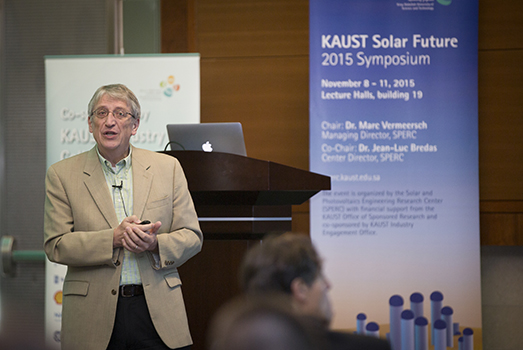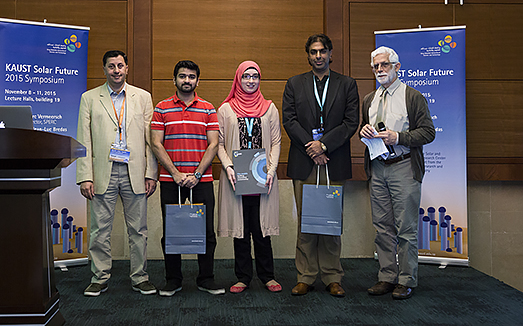Solar Future 2015 Symposium

Jean-Luc Bredas, distinguished professor and director of the Solar and Photovoltaics Engineering Research Center in the Physical Science and Engineering Division, delivers a keynote lecture during the 2015 Solar Future Symposium, November 9, 2015. By Andrea BachofenEcht.
KAUST welcomed a prestigious group of local and international solar energy sector experts from academia and industry to the University's Solar Future 2015 Symposium on November 7-11. The event focused on the most recent results in the field of solar energy conversion (photovoltaics). Representatives ranged from national laboratories, government institutions and universities. The three-and-half-day symposium featured keynote presentations, plenary talks and poster sessions. The event was organized by the KAUST Solar and Photovoltaics Engineering Research Center (SPERC), with the support of the KAUST Office of Sponsored Research and the KAUST Industry Engagement Office.
Emerging solar energy technologies
Solar Future 2015 innovated from the previous series of symposia by delving into both emerging and mature technologies paving the way towards the future of solar energy at high efficiency and low cost. As Ahmed O. Al Khowaiter, Saudi Aramco’s Chief Technology Officer, mentioned in his keynote address, the cost of photovoltaics (PV) has gone down in recent years and is in many ways competitive with energy market prices even in the Kingdom.

Prof. Omar F. Mohammed (SPERC, KAUST) and Prof. Jean-Jacques Pireaux (Université de Namur) with the winners of KAUST Solar Future 2015 Symposium Poster Session, Ahmad Kirmani, Ala'a El Ballouli and Dr. Jafar Khan
“We’ve achieved a lot, but we’ve got a long way to go as well, “ he said. The challenge is to find ways to “scale up the industry as quickly as possible and maintaining the momentum we’ve had over the last five years while ensuring the sustainability of growth,” he noted. The key is essentially to make solar energy much more competitive and scalable.
As part of his talk, KAUST Professor Aram Amassian from the University's Organic Electronics & Photovoltaics Group explored interesting applications opening up within the context of thin-film photovoltaics. One of the key aspects of the materials related to the latter is that they can be solution manufactured and solution printed. “We should be thinking about the science knowledge-base to build a mature industry around solution printing,” said Amassian.
While Amassian’s group at KAUST looks at solution manufacturing from a materials-agnostic perspective, he focused his address at the Solar Future symposium on organics. “There are really interesting challenges there as well as a lot of interesting science,” he pointed out. Being able to manufacture the type of solution that could be applied to large areas with high throughput could dramatically reduce the cost of PV.
When we think about solar cells, the emphasis shouldn’t be only on the absorbing material; it’s also about the whole electron collecting or electron collecting layers (or electron transporting layers). “That has to be part of the equation for making a really efficient all-solution manufacturing solar cell,” Amassian explained. It doesn’t really matter what the ink is; it could be quantum dots, molecules or polymers.
This ink formulation has to be delivered somehow onto a substrate. The method typically used in the laboratory is spin coating. Amassian, however, is interested in moving to something that is more large-area compatible, like flat substrates or a spray coating method that can be applied to more complicated substrates. Eventually this would be done on a large scale.
“It’s about bringing two worlds together,” said Amassian. “These are the world of ink-based manufacturing and solution processing and the world of surface science and vacuum-based sort of thin-film science where there’s a lot of maturity.”
Organics advance in a silicon world
Focusing on organic photovoltaic cells (OPV), Professor Karl Leo from Technische Universität Dresden, and former director of SPERC at KAUST, gave a talk on the current progress and future outlook for organic solar cells. Leo is also the founder of Heliatek, the current world record holder for organic solar cell efficiency at 12%. He said it’s surprising and also disappointing that this record still stands after three years. “I think we would need further progress to achieve a broad application,” he said.
“It’s really clear that the benchmark for photovoltaics is silicon,” Leo clarified. Where, then, is the place for power applications on organics? In order to be suitable for power applications, “organics should reach module efficiency of more than 50%, and the cost must be significantly lower than what silicon can offer,” he noted. Leo believes that this will happen in the long term, but short-term applications have begun to be implemented with building integrations.
Heliatek has recently implemented a pilot project in Singapore in the form of flexible panels for a walkway with an average cell efficiency of 7%. “Those numbers are not really sufficient, but the roadmap is very clear that in the near future they’ll be around 10%, and in 20 years is when the broad market penetration will be possible,” said Leo. The key commercial advantage of the panels is that they can also be made in virtually any color. For building integrations, architects love the colors blue, green and black. “Don’t come to an architect with brown, pink or reddish colors,” he said.
KAUST research recognized
Professor Jean-Luc Bredas, director of the University's Solar & Photovoltaics Engineering Research Center (SPERC), spoke at the symposium about how the performance of organic photovoltaic devices strongly depends on the intermolecular arrangements at the donor/fullerene interfaces. SPERC seeks to strengthen its current core competencies in emerging technologies — organics and hybrids, quantum dots and perovskites — and to enter the more established crystalline silicon and inorganic thin film technologies. Bredas has received the American Chemical Society's ACS Award in the Chemistry of Materials.
Bredas has been conducting groundbreaking theoretical research into new organic materials that can be exploited for novel generations of devices based on organics used as semiconductors. Such devices include light-emitting diodes for displays, field-effect transistors and organic solar cells.
He will be honored at the awards ceremony to be held on March 15, 2016, in conjunction with the 253rd ACS National Meeting in San Diego, California, U.S.
Related Links
- By Meres J. Weche, KAUST News

